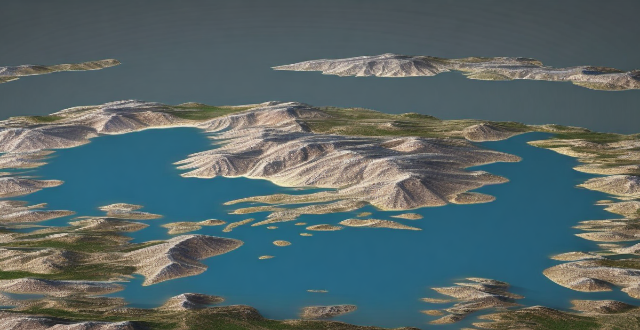Climate Model

How often are climate model predictions updated ?
Climate model predictions are updated as new data becomes available and understanding of the climate system improves, with updates happening regularly. The updating process includes steps like data collection, model evaluation, parameter tuning, validation, publication, and feedback iteration.

How do climate model predictions influence policy decisions ?
Climate model predictions significantly influence policy decisions on climate change by identifying risks, assessing mitigation measures, guiding long-term planning, and fostering international cooperation. These models simulate the Earth's climate system to predict future conditions, aiding in prioritizing actions, allocating resources, and evaluating intervention strategies. However, challenges like uncertainty, data quality, interpretation, and policy inertia must be addressed to ensure effective translation of scientific findings into actionable policies.

What is a climate model and how does it work ?
A climate model is a computational representation of the interactions between various components of the climate system, used by scientists to simulate and understand the behavior of the Earth's climate. It involves data collection, mathematical equations, numerical methods, computational simulation, and model evaluation and validation. There are several types of climate models, including atmospheric models, ocean models, coupled models, ice sheet models, and ecosystem models.

What are the limitations of climate model predictions ?
Climate models are valuable tools for predicting future climate patterns but come with limitations like uncertainty in initial conditions, emission scenarios, and natural variability. Complexities in model processes, spatial and temporal resolutions, computational constraints, feedback mechanisms, and the representation of human interactions add layers of uncertainty. Validation against historical data is imperfect, and ensemble methods help but do not eliminate all uncertainties. These limitations must be considered when interpreting model predictions to ensure informed decision-making regarding climate change strategies.

What factors affect the accuracy of climate model predictions ?
The accuracy of climate model predictions is influenced by various factors including data quality and availability, model complexity and resolution, initial conditions and parameterizations, natural variability and external forcing, and the use of model intercomparison and ensemble methods. High-quality, up-to-date data and comprehensive models that account for multiple physical processes and high-resolution details are crucial. Initial conditions, sub-grid scale process parameterizations, internal climate variability, and external forcing factors add layers of complexity and uncertainty. To mitigate these uncertainties, scientists employ intercomparison projects and ensemble forecasting techniques to assess model reliability and potential future climate scenarios.

What are the implications of inaccurate climate model predictions ?
Inaccurate climate model predictions can have far-reaching implications, affecting various aspects of our lives and the environment. This article will discuss the potential consequences of these inaccuracies and highlight the importance of accurate climate modeling. Misallocation of resources, loss of biodiversity, and increased greenhouse gas emissions are some environmental impacts. Economic implications include costly mitigation strategies, loss of revenue, and uncertainty in investment decisions. Social and health impacts involve displacement and migration, public health risks, and food security threats. Policy implications include weakened climate policy, international relations, and legal challenges. Accurate climate model predictions are crucial for effective environmental management, economic planning, social welfare, and policy development.

How accurate are climate model predictions ?
Climate models are mathematical representations used to predict future climate conditions based on greenhouse gas emissions and other factors. The accuracy of these predictions is complex, influenced by uncertainty, variability, validation against past climate change, ensemble forecasting, continuous improvement, and various limitations. Despite their usefulness, it's crucial to recognize their limitations and uncertainties for informed decision-making about climate change.

What is the role of climate model predictions in disaster preparedness ?
Climate model predictions are crucial for disaster preparedness, helping to understand climate change impacts, improve response planning, enhance community resilience, and promote sustainable development.

How do climate model predictions help in mitigating climate change ?
Climate models help mitigate climate change by identifying risks, developing adaptation strategies, formulating mitigation policies, facilitating international cooperation, and raising public awareness. They provide essential information for decision-makers to plan resilient infrastructure, adjust agricultural practices, implement water management strategies, set energy efficiency standards, establish renewable energy targets, and encourage low-carbon lifestyles.

How do climate model predictions inform sustainable development goals ?
Climate model predictions are vital for guiding sustainable development goals (SDGs) by providing insights into future climate conditions. They help project future climate scenarios, assess risks and vulnerabilities, support policy decisions, promote cross-sectoral collaboration, and enhance public awareness. By using these predictions, policymakers can make informed decisions that promote sustainability and resilience, contributing to the achievement of the United Nations' 2030 Agenda for Sustainable Development.

Can we trust climate models for future predictions ?
Climate models are designed to predict future changes in the Earth's climate based on scientific principles and past observations. Trust in these models depends on factors such as their scientific foundation, data quality, model complexity, intercomparison, historical validation, uncertainty quantification, and continuous improvement. While no model can perfectly predict the future, climate models offer valuable insights into potential future scenarios based on current knowledge and understanding. However, it is important to recognize their limitations and uncertainties when interpreting their results.

What are the limitations of current climate models ?
This article discusses the limitations of current climate models, which are essential tools for predicting future climate conditions and understanding the impacts of human activities on the environment. The main limitations include uncertainty in model inputs, limited spatial resolution, simplified physics and processes, computational constraints, and challenges associated with model intercomparison projects. Addressing these challenges will be crucial for improving our ability to predict future climate conditions and assess potential impacts on ecosystems and human societies.

Does the new iPhone model have a better camera than the previous model ?
The new iPhone model has a better camera than the previous model due to hardware improvements like a larger sensor, increased aperture, and improved optical image stabilization. Software enhancements such as Deep Fusion, enhanced Night mode, and improved Portrait mode also contribute to higher image quality. Sample photos show that the new model produces images with better detail, color accuracy, and dynamic range, especially in low-light situations. Upgrading to the latest iPhone model is recommended for those who prioritize having a high-quality camera on their smartphone.

How accurate are long-term climate predictions ?
Long-term climate predictions are essential for understanding potential future changes in the environment, but their accuracy is often questioned due to the complexity of the climate system. Factors that influence the accuracy of these predictions include uncertainty in emission scenarios, natural variability, and model limitations. However, advancements in climate modeling, such as higher-resolution models, ensemble modeling, and data assimilation techniques, have significantly improved our ability to make accurate predictions about future climate changes. By continuing to invest in research and development, we can further enhance the precision and reliability of long-term climate predictions, providing critical information for decision-makers and the public alike.

How do scientists use climate models to study the impact of human activities on the environment ?
Climate models are mathematical tools used to simulate the Earth's climate system and study the impact of human activities on the environment. The process involves data collection, model construction, scenario analysis, prediction and projection, and continuous validation and refinement. These models help policymakers make informed decisions about reducing greenhouse gas emissions and adapting to climate change.

How do climate model predictions differ from weather forecasts ?
Climate model predictions and weather forecasts differ in terms of time frame, purpose, methodology, accuracy, and impact on decision making, with the former focusing on long-term trends for policy-making and the latter offering short-term insights for daily activities.

Can climate data analysis accurately predict future weather patterns ?
Climate data analysis, utilizing sophisticated climate models based on physical laws and accounting for complex interactions within the Earth system, plays a crucial role in predicting future weather patterns. These models allow scenario-based projections and ensemble forecasting to account for uncertainties. While they are continuously improved as new scientific understanding emerges, it's important to distinguish between weather forecasting (short-term events) and climate prediction (long-term trends). Climate prediction involves more variables, broader trends, external forcings, and wider confidence intervals compared to weather forecasting. However, climate models face uncertainties such as natural variability, model discrepancies, emission scenarios, feedback mechanisms, and regional differences. Despite these challenges, climate science has made progress in predicting aspects like global warming, sea level rise, extreme weather events, regional changes, and carbon cycle responses. In conclusion, climate data analysis can provide valuable insights into potential future climate patterns but comes with inherent uncertainties, especially in forecasting specific weather events far into the future. Ongoing advancements in climate science aid in developing informed policies and adaptation strategies.

How can climate models be used to improve agricultural practices and food security ?
Climate models play a critical role in enhancing agricultural practices and ensuring food security by forecasting weather conditions, mitigating climate change effects, enhancing crop yield potential, and aiding in policy making. Applications include adapting to climate variability through crop diversification and improved plant breeding, strengthening resilience through water management and soil health maintenance. The use of these models is crucial for adapting to changing environmental conditions and ensuring global food security.

How much does the new iPhone model cost ?
The new iPhone model's cost is influenced by storage, color, and carrier. Prices range from $699 for the 128GB iPhone 13 Mini to $1,599 for the 1TB iPhone 13 Pro Max. These prices are for base models without extras, and taxes/shipping may apply.

What are some common misconceptions about climate models, and how can they be addressed ?
The article discusses common misconceptions about climate models and how to address them. The first misconception is that climate models are perfect predictors of future climate conditions, which overlooks the limitations and uncertainties inherent in climate modeling. To address this, it is important to communicate the uncertainty and encourage ongoing research to improve model accuracy. The second misconception is that climate models are not relevant to daily life, which overlooks the potential effects of climate change on individuals and communities. To address this, it is important to highlight the ways in which climate change impacts daily life, such as sea level rise, heat waves, and agriculture. The third misconception is that climate models are biased or manipulated by scientists, which can be fueled by media coverage that focuses on controversy rather than scientific consensus. To address this, it is important to emphasize the rigorous peer-review process involved in climate science research and present a balanced view of the scientific process.

How do I make sure my downloaded wallpaper is compatible with my iPhone model ?
This guide provides steps to ensure downloaded wallpapers are compatible with specific iPhone models, including checking resolution and aspect ratio, using reliable sources, and testing on the device.

How accurate are climate models in predicting future weather patterns ?
Climate models are complex mathematical representations designed to predict future weather patterns. The accuracy of these models is influenced by factors such as data quality, model complexity, and uncertainty in future emissions. Limitations include less accurate short-term predictions and uncertainty in model projections. Potential improvements include better data collection, advances in modeling techniques, and collaboration across disciplines.

Can I use any screen protector for my iPhone model or are they specific ?
Screen protectors are indeed specific to each iPhone model due to differences in size, shape, and design elements such as notches or camera cutouts. To choose the right screen protector for your iPhone model, check compatibility, consider quality and material, look for reviews and ratings, check the installation method, and look for a warranty or return policy.

What are the challenges faced in climate data analysis and how can they be overcome ?
## Topic Summary The article discusses the challenges faced in climate data analysis and proposes solutions to overcome these obstacles. The primary challenges include lack of accessible and reliable data, inconsistent methodologies, limited computational capabilities, and biased or incomplete models. To address these issues, the article suggests collaboration and data sharing among researchers and organizations, standardized methods and guidelines for analysis, cloud computing and remote access for computational needs, and continuous improvement and validation of climate models. By implementing these solutions, researchers can enhance the accuracy and reliability of their climate data analysis, leading to more accurate predictions and effective strategies for mitigating climate change.

How do climate models contribute to our understanding of global warming ?
Climate models are essential in understanding global warming, predicting future scenarios, and informing policy decisions. They range from simple energy balance models to complex coupled atmosphere-ocean general circulation models. These models help project future climate scenarios, understand climate sensitivity, identify feedback mechanisms, assess regional impacts, and inform policy decisions. However, they also have limitations such as uncertainty, computational constraints, parameterization, and incomplete understanding of some feedback mechanisms. Despite these challenges, advancements in modeling techniques continue to improve the accuracy of climate models in guiding our response to climate change.

How do climate predictions account for natural climate variability ?
Climate predictions account for natural climate variability by incorporating natural drivers, using past climate records, ensemble modeling, focusing on long-term trends, assessing uncertainties, scenario analysis, and peer review and revision.

What role do climate models play in developing international climate policies ?
Climate models are crucial for understanding the potential impacts of climate change and identifying areas that require immediate action. They help policymakers project future climate scenarios, assess impacts on ecosystems and human societies, evaluate policy options, and support international negotiations. By providing scientific insights into the potential consequences of climate change, climate models aid in developing effective adaptation strategies and mitigating greenhouse gas emissions.

What is climate forecasting ?
Climate forecasting is the application of scientific knowledge and techniques to predict future climate conditions. It involves analyzing historical and current weather patterns, as well as understanding the physical processes that drive them, in order to make predictions about future climate trends. Key components of climate forecasting include data collection, modeling, analysis, and prediction. Climate forecasting plays a crucial role in various sectors including agriculture, water resources management, energy production, and disaster risk reduction. Despite challenges such as the complexity of the climate system and limited historical data, continued research and advancements in technology will improve our ability to predict future climate trends accurately.

What are the limitations of current climate prediction methods ?
The text discusses the limitations of current climate prediction methods, including model uncertainty, natural variability, scenario dependence, data availability and quality, and computational resources. These limitations can impact the accuracy and reliability of predictions, making it difficult to develop effective strategies for mitigating the effects of climate change. Addressing these challenges will be essential for developing more accurate and reliable climate predictions that can support effective decision-making and adaptation strategies in response to climate change.

How do scientists study and analyze extreme weather events ?
Scientists study and analyze extreme weather events using various methods, including data collection from meteorological stations, satellite imagery, radar, lidar, climate records, and paleoclimate data. They also use numerical weather prediction models, ensemble forecasting, global circulation models, and regional climate models for simulations and predictions. Statistical methods, trend analysis, attribution studies, synoptic climatology, and teleconnections are employed for analysis. Collaboration and public outreach play crucial roles in sharing information and findings.